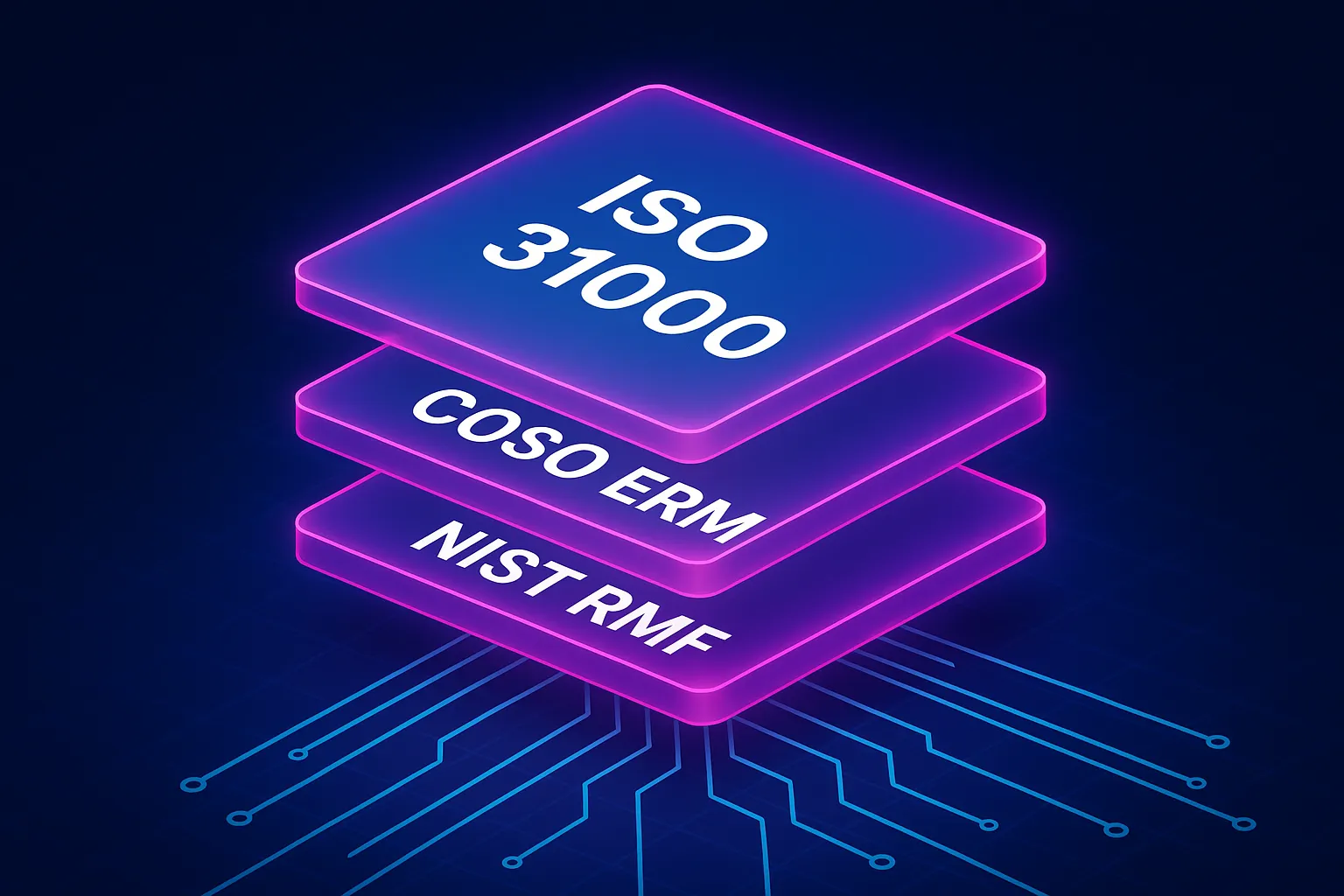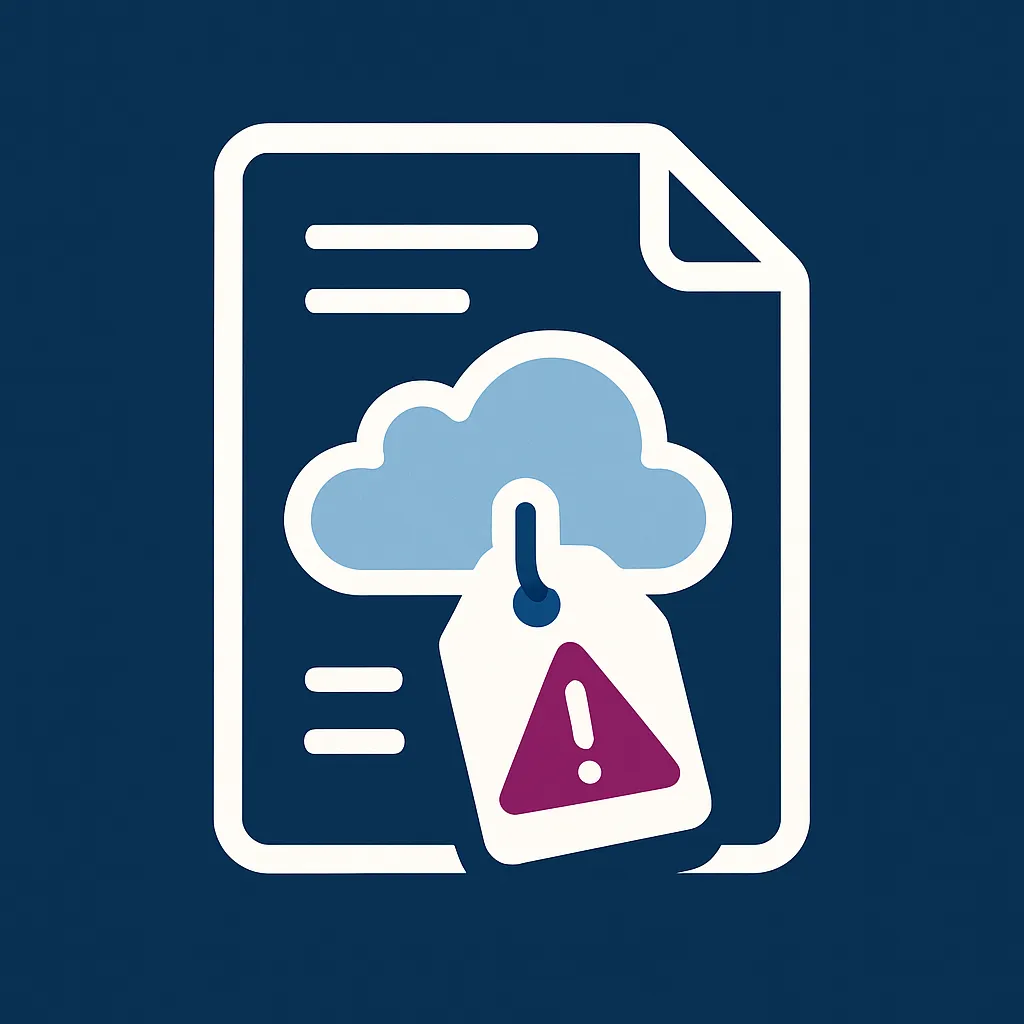Only one in three boardrooms can name the risk-management framework they’re supposed to follow.
If that stat makes you shift in your seat, you’re not alone. In Gartner’s latest pulse survey, audit chairs ranked “unclear risk framework” as their #2 governance blind spot for 2025 - second only to generative-AI oversight.
In my last post I’ve covered philosophy of risk appetite, now let’s see how this philosophy translates into a clear process.
Keep on and discover:
- A plain-English cheat-sheet of the three “big” enterprise frameworks - ISO 31000, COSO ERM, and NIST RMF - and why each one exists.
- Sector-specific overlays bankers, pharma chiefs, and energy operators can’t ignore.
- A five-step decision flow that turns framework paralysis into a board-ready shortlist.
- Real world case-studies showcasing how hybrid approach can work in practice
The Big Three at a Glance: ISO 31000, COSO ERM, NIST RMF
Key term: Risk-management framework - the shared rules and steps a company uses to find, measure, and fix risk.
A two-continent reality check
- Europe: A 2025 Central-Banking benchmark shows 85.7% of institutions rely on ISO 31000 and 64.3% layer COSO ERM on top.
- United States: A 2024 federal-agency survey finds COSO ERM is the top pick for 37% of respondents, while 11% name ISO 31000 as primary (51% pair COSO first with ISO second).
Takeaway: Location shifts the starting point - EU leaders tend to start with ISO 31000, U.S. leaders with COSO ERM.
Side-by-side at a glance
| Framework | Core idea | Best fit | Documentation load* |
|---|---|---|---|
| ISO 31000 : 2018 | Principles first, process second | Cross-industry culture reset; overlays existing controls | 16 pages |
| COSO ERM (2017) | Links risk to strategy & performance via 20 principles | Listed-company reporting; SOX & audit comfort | “120 + pages” |
| NIST RMF (Rev 2) | Seven-step lifecycle tying risk to IT/OT assets | Cyber-heavy enterprises; US-government suppliers | 183 pages |
*Length of the core guidance your team must read.
What real adoption feels like
ISO 31000 - culture first. A slim guide that challenges leadership thinking before controls. No certificate to chase; momentum relies on tone-at-the-top and fast feedback loops.
COSO ERM - controls plus strategy. Five components and twenty principles deliver audit-ready wording for risk appetite, performance, and SEC filings. No wonder Walmart’s auditor signs off without qualifiers.
NIST RMF - technology depth. Begins with asset categorization, ends with continuous monitoring, and maps straight to the NIST SP 800-53 control set. It creates paperwork, but it’s a lifesaver for big cloud systems or U.S. federal contracts.
Three myths that trip up new adopters
- “Pick one and stick forever.” Hybrid usage is already the norm - two-thirds of EU banks overlay COSO on ISO.
- “NIST is only for agencies.” Many EU critical-infrastructure firms adopt NIST controls to satisfy U.S. customer audits.
- “ISO lacks depth.” The coming revision will add sharper guidance on data governance and resilience.
Implementation watch-outs
- ISO can stall in “philosophy mode.” Without a matching list of controls, teams may argue over words instead of fixing problems.
- COSO can feel heavy. At over 120 pages, newcomers often copy every example as if required. Tailor the 20 principles or drown in paperwork.
- NIST needs more effort. Every step creates evidence; if you don’t automate control tracking, the project slows down.
- Mixing frameworks is fine, but you must map the overlaps. Siemens’ public blend works because each overlap is documented in the risk charter. Simple 2-column table mapping ISO principles to COSO components would be a great starting point.
Quick self-test
- Do our board packs cite any framework explicitly?
- Are we subject to U.S. federal data clauses or EU critical-infrastructure rules?
- Is sustainability reporting audited alongside financials?
Answer “yes” twice or more and a hybrid approach is probably in your future.
Fast win
Open your most recent risk-committee slide deck and highlight every reference to frameworks or standards. No mention? Flag the gap for the next governance meeting.
When Sector Rules Rule: Industry-Specific Frameworks
Think of an industry framework as an overlay you stack on top of your enterprise model - an extra layer regulators or customers require when generic guidance is not enough.
Why the overlay trend is here to stay
Global supply chains push firms into multiple regulatory orbits at once. A London hospital group that adopts ISO 31000 for enterprise risk still needs its U.S. tele-health cloud to be FedRAMP authorized, its patient-data environment to earn a HITRUST badge, card payments to pass PCI DSS, and its treasury arm to meet Basel III capital floors.
For EU finance, the Digital Operational Resilience Act (DORA) - effective 17 January 2025 - turns ICT resilience from a best practice into hard law for banks, insurers, brokers, and even crypto-asset providers.
What feels like “extra” in one market is standard in another – and executives cannot ignore the pull.
Key term: Sector framework - a risk or compliance standard written for one industry or regulatory domain rather than the whole enterprise.
Six heavyweight overlays leaders meet most often
-
FedRAMP – public-cloud security (U.S.)
- 95 authorized cloud products so far in 2025, up sharply thanks to the FedRAMP 20x push.
- Average first-time authorization costs about $1 million and can stretch 12-18 months. Even a low-impact system still runs $250k - $500k plus six-figure annual upkeep.
-
HITRUST CSF – healthcare security
- Adopted by 80% of U.S. hospitals and health plans, with 2 500+ assessments completed in 2024.
- Typical certification outlay lands between $70 000 and $160 000 depending on scope.
-
PCI DSS v4.0 – card-payment protection
- In 2024, 90% of merchants using SecurityMetrics guidance reached a passing SAQ on the first attempt – proof the new version is taking hold quickly.
- PCI SAQ prep averages $15k – $30k (+ about 3 weeks) for mid-tier merchants
-
Basel III capital package – banking (EU & UK)
- The EU’s “Basel endgame” took effect 1 January 2025, introducing the standardized output floor; market-risk rules were given a one-year grace period.
- The Bank of England has delayed its own Basel 3.1 start to 2027, showing how timing diverges even inside Europe.
-
TCFD → ISSB climate disclosure
- TCFD (Task Force on Climate-related Financial Disclosures): Framework for Climate Transparency.
- ISSB (International Sustainability Standards Board): The Global Standard for Sustainability Reporting.
- 82% of 3 814 public companies disclosed at least one TCFD-aligned metric in 2023, yet fewer than 3% cover all eleven recommendations – a gap investors are watching closely.
-
DORA - banking, insurance, crypto (EU)
- 94% of EU financial institutions have launched a DORA programme, but only 4% report its controls already became “business-as-usual”.
- Most institutions report north of EUR 5M in program setup costs and up to 7 FTE allocation during the peak time (audits/contract renegotiations).
Cost and complexity – the blind spots
- Hidden run-rate spend – FedRAMP demands continuous monitoring reviews every month; budget roughly 20% of first-year costs for annual maintenance.
- People bandwidth – A mid-sized cloud vendor averages 5-7 FTEs for nine months during a FedRAMP push, versus 1-2 FTEs over six months for HITRUST. DORA requires organizations to continuously monitor 3rd-parties supporting critical business functions - unless staffed properly, your internal audit team might stretch too thin.
- Audit collision risk – Overlapping evidence requests (e.g., vulnerability scans) can overwhelm teams if schedules are not staggered.
- Geo divergence – EU banks must absorb Basel III floors now, while their U.S. peers still debate implementation – creating competitive tension in capital planning. But unlike US, EU financial entities have to layer DORA on top of their risk framework.
Signals you cannot ignore a sector overlay
- You provide financial services in EU (DORA).
- A regulator or customer contract cites it by name.
- Non-compliance blocks revenue (e.g., FedRAMP is mandatory for U.S. federal sales).
- Your board’s risk appetite flags the underlying exposure as “material”.
- Investors face disclosure rules you must support (TCFD/ISSB).
Quick pulse-check for your risk lead
- Do we store or transmit protected data (cardholder, patient, classified)?
- Are we bidding on U.S. federal, EU banking, or UK public-sector contracts?
- Has any customer RFP referenced a specific framework in the past 12 months?
- Would missing the framework delay revenue or capital access?
- Do we have dedicated budget and owners for sector audits?
- Do we plan to launch any financial services in EU?
Quick check
Pull your three largest customer contracts and highlight every clause that names a framework (FedRAMP, PCI, etc.). Note the internal owner for each clause so gaps surface before the next renewal.
From Debate to Decision: A 5-Question Diagnostic
Key terms:
- Framework paralysis – the costly delay that sets in when leaders cannot agree which risk framework to use.
- Risk appetite – the amount and type of risk your organization is willing to take or retain to reach objectives.
The productivity cost of indecision
- 61% of managers say at least half of the time they spend making decisions is wasted - the equivalent of 40k lost manager-days a year at an average Fortune 500 company.
- Only 37% of organizations report their decisions are both fast and high quality.
- In the U.S. public sector just 47% of agencies have even written a risk-appetite statement - proof that many teams stall before basics are in place.
- Speed does not have to hurt quality: teams that decide quickly are 2x more likely to rate their decisions as high quality.
Bottom line: time spent arguing frameworks is time without controls on the ground.
The 5-step decision flow
Work through the questions in order. A single yes often locks in your baseline.
-
What do directors already recognize? If board minutes or audit reports mention ISO 31000 or COSO ERM, begin there - executive endorsement beats theory.
-
Are we legally bound?
- U.S. federal sales require FedRAMP.
- EU financial entities fall under DORA from 17 January 2025.
- Card data means PCI DSS. A mandated framework sets your minimum.
-
Is cyber risk material to revenue? A “yes” points to the control depth of NIST RMF or a NIST-mapped sector guide (e.g., HITRUST).
-
Do we publish assured sustainability or climate reports? COSO ERM’s 2023 guidance on Internal Control over Sustainability Reporting gives ready-made controls that auditors already trust.
-
Do we operate in three or more regulatory regions? Hybridizing ISO 31000 principles with the most relevant sector overlay keeps governance coherent and avoids rule conflicts.
Case snapshot - turning answers into action
A mid-market auto-parts manufacturer answered yes to Q2 (PCI DSS) and Q3 (material cyber exposure) but no elsewhere. They:
- Adopted ISO 31000 as the enterprise backbone for culture and terminology.
- Mapped PCI DSS v4.0 controls to ISO objectives for payment flows only.
- Applied NIST RMF tasks to production-line systems with internet connectivity. The hybrid went live in eight months; audit findings dropped 30% in the first year.
From shortlist to roadmap
- If Q1 or Q2 triggered: start with the named framework, then run a short gap analysis against ISO 31000 principles to spot cultural blind spots.
- If Q3 or Q4 triggered (but no legal driver): bolt the relevant annex (NIST or COSO ESG) onto ISO 31000 - one set of policies, two sets of controls.
- Only Q5 triggered: pick ISO 31000 as the backbone, schedule sector overlays in priority order so teams are not flooded.
How to act
Block 15 minutes at your next executive-risk meeting to answer the five questions aloud. Capture the first framework each yes selects and circulate the resulting shortlist before the meeting ends.
Building a Hybrid Approach - and Keeping It Coherent
Key terms:
- Hybrid framework - a deliberate blend of two or more risk standards that lets you satisfy unique regulatory, strategic, or cultural needs without doubling governance work.
- Control cross-walk - a mapping that shows where requirements in one framework meet, exceed, or diverge from those in another.
Why hybrid thinking is surging
- 86% of central banks use ISO 31000 while 64% also run COSO ERM in parallel - highlighting importance of a cultural mindshift and strategic control alignment.
- Risk teams are demanding better visibility: interactive risk-map tools jumped from 33% adoption in 2022 to 71% in 2024, a leap driven by the need to align multiple frameworks on one dashboard.
- COSO’s new Corporate Governance Framework exposure draft (open for comment May 27 - Jul 11 2025) explicitly invites cross-framework alignment - a signal that hybrids are becoming mainstream board practice.
“A single framework rarely meets every law, investor expectation, and culture standard. Smart teams mix controls instead of multiplying them.”
Four-step integration playbook
-
Map principles first
Align high-level concepts (governance, strategy, culture) between ISO 31000, COSO, and any sector rule such as DORA. A one-page matrix prevents philosophical clashes later.
-
Cross-walk the controls
Use an automated tool or spreadsheet to match each requirement once and only once. Modern GRC platforms now “smart-map” a single control to multiple frameworks, cutting duplicates by up to 40%.
-
Align governance cadence
Sync board dashboards, audit committee calendars, and risk-owner reporting so each control shows up in one place at one time. COSO’s draft governance framework offers fresh language you can lift straight into charters.
-
Monitor - and prune
Quarterly, drop any control that no longer maps to a live requirement. The Institute of Internal Auditors now teaches dedicated workshops on trimming dead weight from integrated frameworks.
Smart tools that do the heavy lifting
- Auto-mapping engines (e.g., Centraleyes, leading GRC suites) surface overlaps instantly and show which new regulatory text (like DORA RTS) adds net new work.
- Visual flow builders let you tie risk events to controls from multiple frameworks and push evidence requests to owners on a single timeline.
- Control libraries with versioning preserve history so auditors can see why a duplicate was retired, not just that it vanished.
Pitfalls to watch
- Control bloat - every sector add-on can add 10-15% extra controls if you don’t prune overlaps.
- Audit confusion - two standards, two vocabularies; agree early which terms (“risk owner”, “process owner”) appear in every report.
- Geo divergence - EU’s DORA goes live in January 2025 while the Bank of England delays Basel 3.1 to 2027, so UK-based groups may juggle different go-live dates.
UK case snapshot: how one challenger bank keeps it tidy
Starling Bank refreshed its Enterprise Risk Management Framework in 2025 to stay aligned with “evolving regulation, corporate governance, and industry good practice,” blending its ISO-rooted culture with PRA and Basel demands under one policy spine.
Quick hybrid health-check (do it now)
- List every framework or standard cited in last quarter’s board papers.
- Circle any requirement that appears twice - you just found duplication.
- Check if one GRC control could satisfy both citations; if yes, mark the higher standard and retire the duplicate at the next review.
This simple pass keeps hybrid governance lean without more than a few minutes of executive time.
Closing Thoughts
Framework names can feel like alphabet soup, yet behind each acronym sits the same leadership question: how bold are we willing to be in pursuit of our goals. Once the board chooses a backbone - every overlay becomes a conscious, strategic layer rather than regulatory clutter. The five questions you answered are not a checklist to archive but a lens you can reuse whenever external conditions change. And the hybrid map you craft is less a document than a living contract between strategy and execution, trimmed at each quarterly review.
Put differently, risk frameworks reward momentum. One focused conversation with the right people will do more than an extra week of reading. Convene that session, expose the overlaps, retire the duplicates, and let your control owners catch their breath. In the next post we will turn this newly clarified architecture into daily routines, metrics, and tooling that scale with the ambition of your organization.


